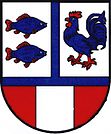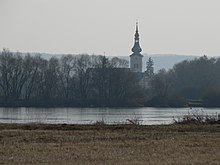Moravicany
| Moravicany | ||||
|---|---|---|---|---|
|
||||
| Basic data | ||||
| State : |
|
|||
| Region : | Olomoucký kraj | |||
| District : | Šumperk | |||
| Area : | 1215 ha | |||
| Geographic location : | 49 ° 45 ' N , 16 ° 57' E | |||
| Height: | 243 m nm | |||
| Residents : | 1,317 (Jan 1, 2019) | |||
| Postal code : | 789 82 | |||
| License plate : | M. | |||
| traffic | ||||
| Street: | Loštice - Moravicany | |||
| Railway connection: | Olomouc - Zábřeh | |||
| structure | ||||
| Status: | local community | |||
| Districts: | 3 | |||
| administration | ||||
| Mayor : | Antonín Pospíšil (as of 2009) | |||
| Address: | Moravičany 67 789 82 Moravičany |
|||
| Municipality number: | 540480 | |||
| Website : | www.obec-moravicany.cz | |||
Moravičany (German Moravichan ) is a municipality in the Czech Republic . It is located four kilometers southeast of Mohelnice and belongs to the Okres Šumperk .
geography
Moravičany is on the left side of the Třebůvka , immediately before its confluence with the March , in the south of the Müglitzer Furche ( Mohelnická brázda ). The municipality is located on the north-western edge of the Litovelské Pomoraví Protected Landscape Area . To the north lies the Moravičanské jezero nature reserve, which consists of two quarry ponds. In the northeast rise the Jelení vrch ( Hirschenhübel , 345 m) and Velký Bradlec ( Großer Bradletz , 341 m), east of the Hradisko (316 m) and in the southeast of the Mlýnský vrch (306 m).
Neighboring towns are Třeština and Stavenice in the north, Úsov in the north-east, Králová in the east, Nový Dvůr, Nové Zámky and Nové Mlýny in the south-east, Doubravice and Palonín in the south, Loštice in the south-west, Líšnice , Horní Krčmy and Dolní and Dolní Krčmy in the west and Dolní and Dolní Válce in the west Mohelnice in the northwest.
history
According to archaeological finds, the area around Moravičany has been inhabited since the Neolithic Age. On Velký Bradlec there are 15 burial mounds of the Lusatian culture and on Hradisko there is an old Slavonic castle. The place was populated by Celts and Slavs since the 6th century .
Moravičany was first mentioned in a document in 1249. In 1380 the brothers Johann and Peter von Rosenberg left their property in Moravičany, including the church, to the Litomyšl diocese , which soon gave the property to the Tržek Charterhouse . From 1397 Moravičany belonged to the Dolany Charterhouse , which was extinguished during the Hussite Wars. Her successor was the Olomouc Charterhouse . The village was devastated during the Thirty Years War. In the hoof register of 1677 there are 61 properties for Moravičany, all of which were again managed. The first evidence of a school in Moravičany comes from 1679. After the abolition of the Olomouc Charterhouse in 1782 as part of the Josephine reforms , Moravičany came under the secular rule of Doubravice. In 1786 the Moravičany farm was parceled out and the new settlement Tkanowitz was founded by German settlers. In the following years Tkanowitz was Czechized. In 1834, 606 people lived in Moravicany's 100 houses. At that time there were 16 houses in Tkanowitz that were inhabited by 99 people. In 1845 the railway from Olomouc to Prague was built north of the village .
After the abolition of patrimonial Moravicany / Moravichan and the district Tkanowitz / Tkanovice formed a municipality in the Hohenstadt district . In 1860 the whole village burned down. It was not until 1890 that the Moravičany-Loštice railway station was built , which also served the town of Loštice . In 1918 a wood goods factory was founded. After the Munich Agreement , Moravičany was occupied by the Wehrmacht in October 1938, but the place had to be returned to Czechoslovakia . Moravičany was then removed from the Hohenstadt district and assigned to the Litovel district . The population actively participated in the resistance against the National Socialists . After the end of the Second World War, the community came back to Czechoslovakia and from then on belonged again to the Okres Zábřeh. After its dissolution, the municipality came to Okres Šumperk in 1961 . 1976 Doubravice and Mitrovice were incorporated. In 1997 the municipality was hit by a flood of the March of the century.
Community structure
The municipality Moravičany consists of the districts Doubravice ( Doubrawitz ), Mitrovice ( Mitrowitz ) and Moravičany ( Moravichan ) as well as the locality Tkanovice ( Tkanowitz ) and the forest house U Josefka.
Attractions
- Church of St. George, built at the end of the 15th century. It was given its present form during renovations in 1615 and 1753. The frescoes were created by the painter GK Handke.
- Rectory, built around 1600 as a Renaissance building
- School, verifiable since 1679
- Burial chapel in the cemetery, classicist building from the mid-19th century
- Moravičanské jezero nature reserve, the two quarry ponds in the March floodplains north of the village are a breeding area for water birds. It was therefore placed under protection in 1994 on 92.16 hectares.
- prehistoric burial site on Velký Bradlec, the group of 15 burial mounds dates back to between 1500 and 1300 BC. And is attributed to the Lausitz culture .
- Slavic fort on the Hradisko
- Chapel of St. Florian, on the village green
- Atonement Cross at the Chapel of St. Florian, from the 16th century
- Baroque group of statues of the Virgin Mary, St. Florian and St. John of Nepomuk, in front of the bridge, created in 1703
- Chapel in Tkanovice
- Chapel in Mitrovice
- Chapel in Doubravice
Former iron bridge
The 30.6 m long iron bridge over the Třebůvka, which was made in the iron works of the Klein brothers in Zöptau in 1888 , was the oldest iron road bridge in Okres Šumperk . In 1985 the original roadway was replaced by a reinforced concrete ceiling. The poor condition of the structure, especially the no longer secure statics, led to the demolition of the bridge on April 9, 2009 and replacement by a new building.
Sons and daughters of the church
- Karel Jílek (1896–1983), painter
Web links
- Description of the community
- Portrait of the municipality on the pages of the Mohelnicko microregion
- Presentation on nasemorava.cz
- Website about the community






